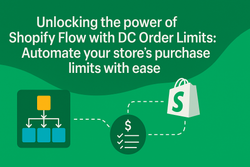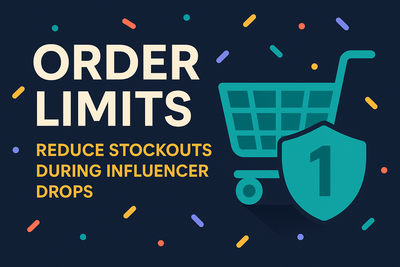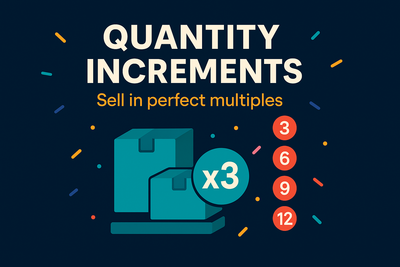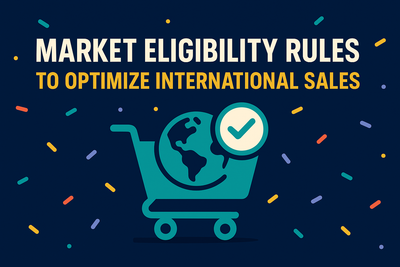In the world of e-commerce, few strategies are as subtly powerful as implementing purchase limits. While they might seem like simple inventory management tools, purchase limits tap into deep psychological principles that can significantly influence how customers perceive your products and interact with your store.
Let's explore how strategic inventory rules not only protect your business but can actually drive sales and build stronger customer relationships.
The psychology of scarcity: Why less is sometimes more
When customers see messages like "limit 2 per customer" or "only 5 left in stock," something interesting happens in their minds. This perception of scarcity triggers what psychologists call "loss aversion" - the idea that people are more motivated by the fear of missing out than by potential gains.
Research has consistently shown that products perceived as scarce are valued more highly. A limited quantity signals exclusivity and quality, pushing customers toward quicker purchasing decisions. In fact, a study published in the Journal of Consumer Research found that products with purchase limits were perceived as 17% more desirable than identical products without limits.
This isn't just theoretical. Major brands like Nintendo have masterfully used limited releases to drive demand, creating product frenzies that keep their items in the spotlight long after launch.
Purchase limits as social proof
When customers encounter purchase limits, they subconsciously receive a powerful message: "This product is so popular that we need to ensure everyone gets a chance to buy it." This functions as a form of social proof—evidence that others value the product highly.
This psychological trigger works particularly well for new product launches or during sales events. When a customer sees a purchase limit, it validates their interest in the product and can accelerate their decision to buy.
Balancing fairness and exclusivity
One of the most overlooked benefits of purchase limits is how they position your brand ethically. By preventing inventory hoarding, you signal to customers that fairness matters to your business.
This is especially important during high-demand periods or limited releases. Customers appreciate knowing they have an equal opportunity to purchase products, rather than losing out to resellers or bots that might grab all available inventory in seconds.
Sephora's approach during their VIB sales exemplifies this strategy effectively—limiting quantities of popular items ensures more customers can participate in special promotions, building goodwill while simultaneously creating urgency.
The data behind optimal limit setting
Setting purchase limits isn't about picking random numbers. Strategic limits require understanding your customer purchasing patterns and inventory cycles.
Analysis of purchase data across various e-commerce platforms suggests that the most effective limits typically allow for:
- Enough quantity to satisfy genuine customer needs (avoiding frustration)
- Low enough to create perceived scarcity
- Aligned with typical purchase volumes for your product category
For instance, limited edition cosmetics might have a "2 per customer" limit, while everyday essentials might have higher thresholds that still prevent bulk buying.
Inventory visibility strategies
The decision to show or hide exact inventory counts plays directly into purchase limit psychology. When paired with strategic limits, inventory visibility can create powerful purchase incentives:
- Showing exact counts: Creates urgency when stock is low
- Showing threshold indicators: "Less than 10 left" creates urgency while protecting exact inventory data
- Hiding inventory: Shifts focus to product value rather than availability
Each approach has its place, depending on your product type and sales strategy. Testing different approaches with similar products can reveal which inventory visibility strategy works best for your specific customer base.
Purchase limits as customer relationship tools
Beyond the immediate sales impact, purchase limits can actually strengthen long-term customer relationships. By ensuring fair distribution of limited inventory, you signal that you value each customer's experience over maximizing short-term profits.
This fosters trust and loyalty, particularly among your most engaged customers. They recognize and appreciate that your business prioritizes fairness, even during high-demand periods when you could potentially allow bulk purchases.
Implementing strategic purchase limits in your store
Ready to apply these psychological principles in your own store? Here's how to implement purchase limits strategically:
- Analyze your data: Understand typical purchase quantities before setting limits
- Segment your products: Different categories may require different limit strategies
- Communicate clearly: Ensure purchase limits are visible before customers reach checkout
- Test and refine: Monitor how different limit structures impact conversion rates
- Consider timing: Limits may need adjustment during sales events or seasonal peaks
Modern inventory management tools make implementing these strategies simple. Apps like DC Order Limits allow you to create sophisticated rules based on products, collections, or customer segments without complex coding.
Case study: How purchase limits transformed one merchant's holiday season
A specialty candle shop implemented strategic purchase limits during their holiday season launch last year. By limiting their most popular seasonal scents to 3 per customer, they reported:
- 25% increase in overall conversion rate
- Inventory lasted 2 weeks longer than previous years
- 42% more unique customers made purchases
- Customer satisfaction scores improved by 18%
Most importantly, they received positive feedback from customers who appreciated being able to purchase seasonal favorites that had sold out too quickly in previous years.
Finding your purchase limit sweet spot
The most effective purchase limits find the balance between creating psychological urgency and frustrating customers with overly restrictive policies. This sweet spot varies by:
- Product category and typical use patterns
- Price point and replenishment cycle
- Customer segment (new vs. returning customers)
- Season and promotional context
By approaching purchase limits as strategic marketing tools rather than merely inventory management mechanisms, you can tap into powerful psychological triggers that not only protect your stock but actually enhance how customers perceive your products.
The next time you set a purchase limit in your store, remember: you're not just managing inventory—you're sending subtle psychological signals that can transform browsing customers into buyers, and casual shoppers into loyal fans.
Ready to implement strategic purchase limits in your Shopify store? DC Order Limits makes it easy to create and manage sophisticated inventory rules that drive sales while protecting your products.








